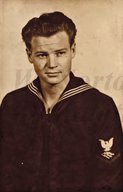
|

|
|
|
|
This Louisiana singer, songwriter, and World War II veteran was born in Cedar Grove, Louisiana, as one of seven children of Giles and Naomi Simpson King. The family soon moved to Keithville. When he was twelve, they re-located to Summer Grove. Claude describes the home where he grew up as having "big cracks in the floors," where "air would come through there in the wintertime and get really cold. We'd use mud and clay and stuff with grass in it to stop the cracks up." The Kings heated their house with a fireplace, cooked on a wood stove, and lit the interiors with coal oil lamps. Claude helped out on the farm, including picking cotton. "We started at sunrise and picked until sunset," he says. "We didn't have a clock to go by. When the sun came up we needed to be working and when it went down we could quit." They slaughtered hogs in cold weather in the late fall and winter, and preserved the pork in a smokehouse. They also harvested sugar cane and sorghum and made syrup by pressing juice from the stalks in a mill powered by a mule. They ground their own corn for meal, and sold eggs to buy flour and sugar. His mother made only cornbread and biscuits. "I never ate a piece of bread, you know, light bread we call it, until I was grown," he reveals. One "luxury" the family owned was a battery-powered radio. "Daddy, didn't want to run the battery down," Claude recalls. "He wanted to be able to hear Amos `n Andy, but he'd let me listen to The Grand Ole Opry once in a great while." At sixteen, Claude joined the Civilian Conservation Corps (CCC), soon after his older brother signed up, and was stationed near Winfield, Louisiana. He helped in irrigation work for farmers, and took classes in forestry, landscaping, and welding. He left the CCC after six months and worked at J.B. Beaird Company in Shreveport as a molder. He was playing in a band, The Rainbow Boys, with Tillman Franks and Buddy Attaway, when Pearl Harbor was attacked. Although still in high school, Claude joined the U.S. Navy on July 29, 1942. "I didn't even know about Hitler," he says. "I didn't know what was going on over there. All I knew is that Japanese had attacked Pearl Harbor, and I wanted to get involved." His three brothers joined as well. During the war, Claude saw one brother by chance in San Diego. Later, while overseas, he saw another on Saipan. After boot camp in San Diego, Claude was sent to the University of Idaho for radio and radar school, then to Oceanside, California, where he underwent commando training. He sailed to the South Pacific on the USS Harris (APA-2) a troop transport ship. (He would later serve on several other vessels, including the USS Casco (AVP-12) the USS Clay (APA-39) the USS Knox (APA-46) the USS Latimer (APA-152) and the USS Neshoba (APA-216). A radioman first class, Claude was in charge of all radiomen when the Harris transported troops to Kiska and Attu, Alaska. "That was the first invasion in the Pacific, the Attu islands," he says. He went ashore at Kiska and set up ship-to-shore communications. From Kiska he sailed into the South Pacific for the invasion of the Gilbert Islands, where he saw action at Tarawa. He noticed the poor marksmanship of gunners aboard ships as Japanese planes zoomed down on them. "A Jap plane would come over and they'd fire at the thing for twenty minutes and never could bring it down," he says. "I guess some of those pilots were probably dead by the time they hit the water. All that fire; just steady sky of fire around that plane." After Tarawa he steamed to Apamama, an atoll ninety miles away, where, with "forty, fifty other guys off the ship," he was stationed for six months in establishing and maintaining ship-to-shore communications. For several weeks the group survived on little food and without medical supplies. "Everybody got diarrhea," he says. "They opened a big tent. I remember I got in there and they put me in this tent and all I could have was a glass of warm tea and soda crackers until I got well. We were bombed every night and had to get in a foxhole." Sent to Pearl Harbor for rest and recuperation, he was assigned to the Neshoba, and was aboard it when the war ended. The Neshoba pulled into Yokohama where he witnessed hunger among Japanese civilians. "Those people were all starving to death there, eating out of garbage cans - kids, and everybody," he recalls. "Money was piled up there, ten-foot high piles of money. It wasn't any good. You couldn't buy nothing...They were all starving there, little ol' kids running around digging in the garbage cans trying to find a scrap or two. Starving dogs, everything. I don't know how they held out as long as they did." He was discharged as radioman first class in New Orleans on December 10, 1945. He married Barbara Coco in February of 1946. She was fifteen, but soon resumed high school and graduated. Claude went on to develop his music career (see OH-412) that spanned several decades. He was known largely for his hit song, "Wolverton Mountain." Late in life he performed on the Grand Ole Opry, receiving a standing ovation. |


